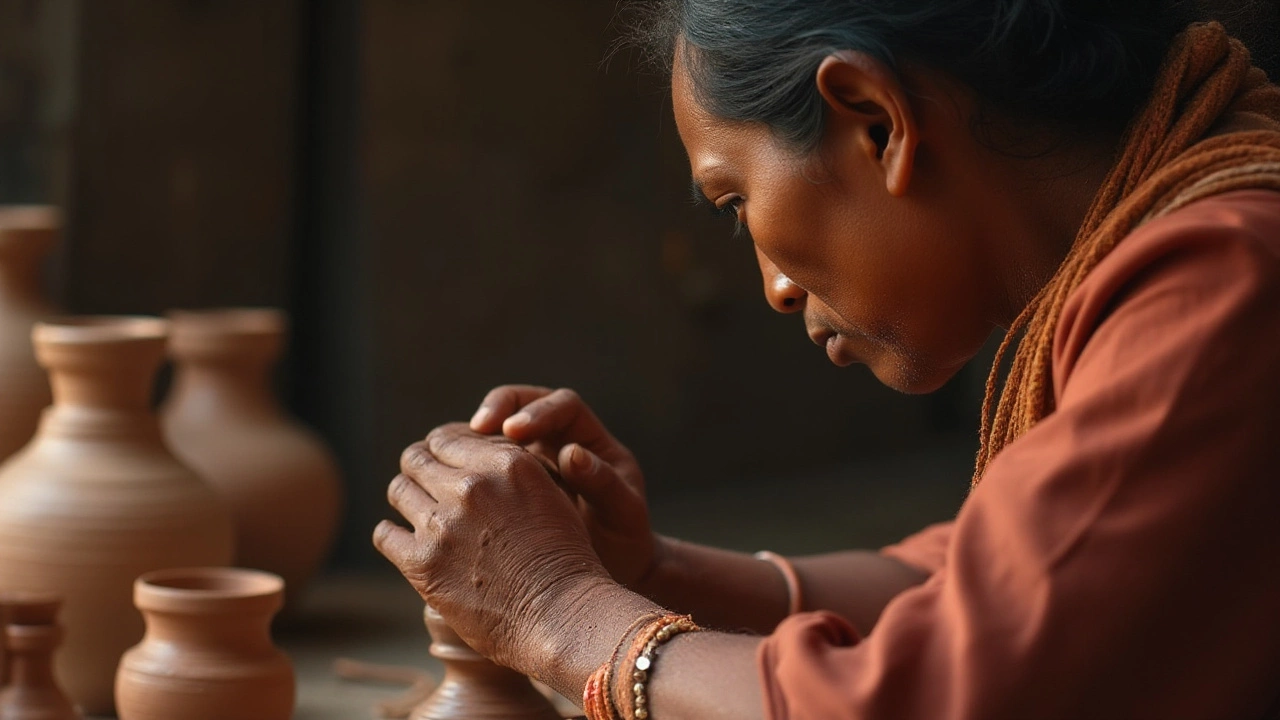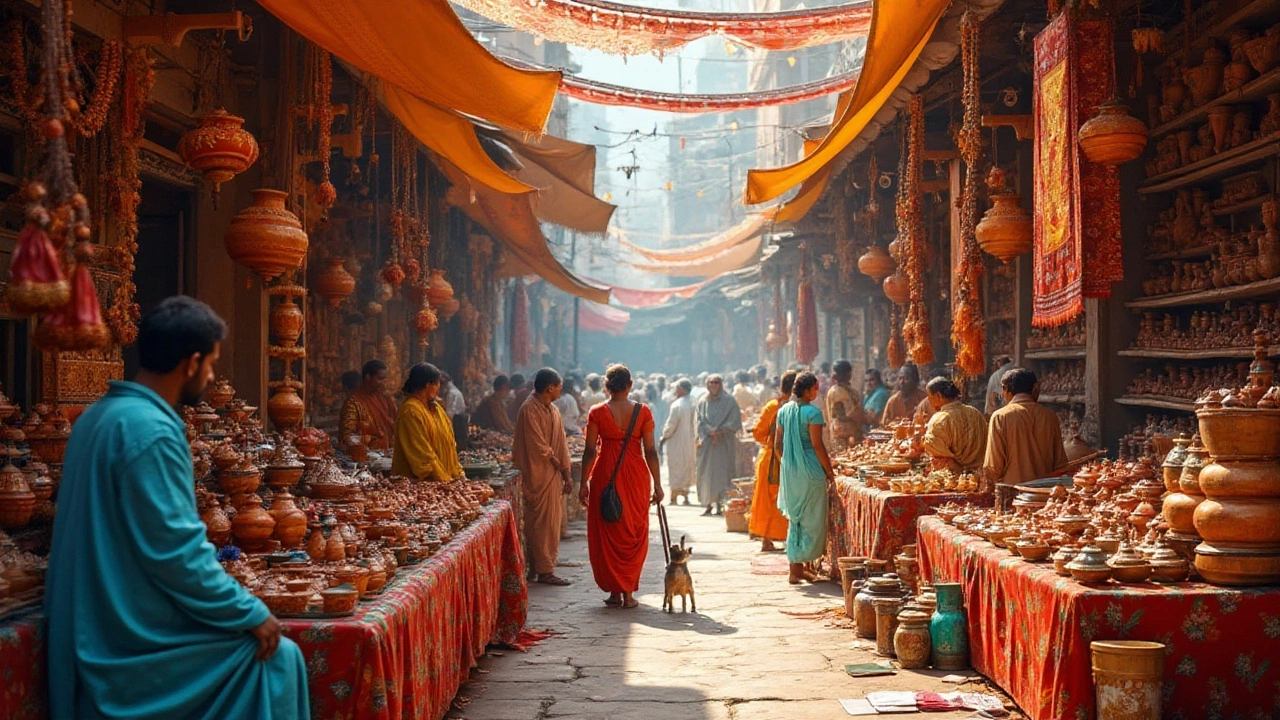India's handicrafts are a testament to its rich cultural tapestry. These creations, painstakingly made by skilled artisans, hold stories of tradition, heritage, and artistic finesse.
Whether one is drawn to the vivid colors of Indian textiles, the intricate designs in pottery, or the shine of handcrafted jewelry, each piece is a glimpse into history and an emblem of cultural pride. Today, these crafts not only preserve ancient techniques but also meet the global thirst for authenticity and sustainability.
Join us as we explore the charm and increasing demand for some of India's most cherished handmade products.
- The Allure of Indian Textiles
- Pottery: Tradition Molded in Clay
- Jewelry: Timeless Pieces of Art
- Sustainable Craftsmanship and Global Appeal
The Allure of Indian Textiles
The legacy of Indian textiles weaves an extraordinary narrative of artistry and tradition, bringing life to fabric with vibrant hues and rich, intricate designs. Spanning centuries, these textiles not only showcase the imaginative skill of the artisans but also capture the cultural stories of various regions in the country. From the Mughal era of luxurious garments filled with fine embroidery to the everyday wear daily infused with bold, decorative motifs, India's textile industry is deeply rooted in its history and culture. One cannot overlook the exquisite craftsmanship seen in works such as Banarasi silk, which takes as much as 15 days to several months to complete, depending on the intricacies involved. There is also the Chanderi fabric, renowned for its light, glossy texture and transfixing patterns, often peppered with motifs inspired by the wildlife and nature of its place of origin.
Different regions possess their unique textile heritage. Take, for instance, Kashmir, famous for its pashmina shawls, delicately crafted to provide warmth without sacrificing grace. The bright reds, deep blues, and subtle creams create intricate designs with perfect symmetry that speaks to the Kashmiri artistry's greatness. Down south, Kerala has its rich Kasavu saris — minimalistic yet elegant designs marked by their unassuming cream hue bordered by golden threads. It's impressive to note that these textiles are not merely confined to tradition but are constantly evolving to blend with contemporary fashion sensibilities. The global appeal of these textiles has led to increasing demand in international markets where people seek to add a touch of Indian culture to their lives.
"Textiles of India represent a unity in diversity with their diverse designs and forms yet combining to forge a country’s unique identity." - Amitabh KantBy embracing more sustainable approaches, many are opting for handmade textiles that support the handicraft ecosystem. This preference reflects a growing consciousness of environmental impact, allowing traditional techniques to align with contemporary needs. Artisans now infuse their age-old skills with organic dyes and sustainable fibers, ensuring the preservation of invaluable craftsmanship. As people around the world lean towards ethical consumption, Indian textiles stand as a symbol of eco-friendly elegance.
The enduring beauty of Indian textiles lies in their versatility, connecting artists with admirers from diverse cultural backgrounds. Artisans pour a part of their soul into every piece, making it a living testament to artistry passed down through generations. India, through its textiles, offers an invitation to experience the depth of its culture, a vibrant glimpse into the myriad stories that the threads carry.
Pottery: Tradition Molded in Clay
Pottery in India is not merely a craft; it is a historical narrative molded in clay. This ancient art form dates back to the Indus Valley Civilization, where communities crafted pots and terracotta sculptures, driving the evolution of domestic and spiritual practices. Each region in India boasts its distinctive style, reflecting the cultural and geographical influences that have shaped it over centuries. From the earthy tones of Rajasthan's blue pottery to the vibrant hues of Gujarat's terracotta, these pieces are windows into regional histories and tell stories of the land and its people.
Indian pottery takes many forms, ranging from utility items for everyday use to elaborate decorative pieces that adorn households. In the southern region, the famed Kerala pottery captures the essence of coastal traditions with its distinctive red and black hues. Meanwhile, in the northern terrains, the rustic appeal of Madhya Pradesh's clay craft emerges through its simplicity and earthy finish. An artisan's connection to the clay is profound, and this bond is evident in the tactile, smooth, or textured surfaces of their creations. These pieces, more than just objects, hold emotive value, symbolizing tradition, community, and the artisan's creativity.
"The potter's wheel is a circle of life, grounding the hands in tradition while allowing the heart to soar with creativity." - Unknown Indian Artisan
Despite the mass production of ceramics threatening traditional pottery, there is a renaissance of appreciation for handcrafted Indian pottery. Globally, there is a rising demand for unique and artisanal goods, and Indian handicrafts meet this need with their ancestral craftsmanship. Pottery is not just a utility but a piece of heritage that anyone can hold, touch, and cherish. It is the interplay of sustainable practices and cultural richness that captures the spirit of true artistry.
As the world leans toward sustainability, handmade pottery is gaining attention for its eco-friendly processes. Traditional potters often utilize locally sourced, natural materials, minimizing the carbon footprint and supporting the local ecosystems. Some are incorporating traditional methods with modern techniques, such as non-toxic, lead-free glazes, which cater to health-conscious consumers. These potters continue to shape a vibrant future for this age-old craft.
Famous Pottery Styles
Within India's pottery varieties, certain styles have achieved iconic status. Each reflects its specific cultural backdrop while contributing to the rich tapestry of handmade products. Blue pottery of Jaipur, with its Persian origins, is known for its eye-catching cobalt blue dye, promoting a look both elegant and exotic. Conversely, Uttar Pradesh's Khurja pottery is celebrated for its remarkable durability and intricate floral patterns. Then there is the black pottery of Nizamabad, infamous for its delicate engraving techniques and deep black sheen derived from a unique clay firing process. Such diversity within Indian pottery ensures that these crafts continue to hold a special place in aesthetic and cultural appreciation.

Jewelry: Timeless Pieces of Art
Jewelry making in India is not just about making beautiful accessories; it is an exploration of art that intertwines spirituality, tradition, and creativity. For centuries, Indian jewelry has been a symbol of power, prestige, and tradition. Ranging from the sparkling kundan to the ethereal meenakari, these products are deeply embedded in Indian culture and history. Crafted with precision and artistry, each piece tells a unique story, encapsulating the essence of the culture that hailed its creation. The rich history of Indian handmade products in the form of jewelry takes one on a journey through time, exploring various styles and techniques passed down through generations.
The Ancient Roots and Techniques
Historically, Indian jewelry has been influenced by various dynasties and cultures. The ancient temple jewelry of South India, known for its bold designs and exquisite craftsmanship, continues to thrive in modern-day weddings and cultural festivals. Techniques such as filigree and granulation, which can be traced back to ancient civilizations, find special mention in this artistic tradition. These methods involve intricate metalwork, transforming precious metals into masterpieces that stand the test of time. This art form requires precision skills, often perfected through years of dedicated practice and passion.
Delhi's famous Dariba Kalan market, reputed for its silver trinkets, draws inspiration from Mughal artistry, known for its emphasis on ornate designs. Each piece of jewelry is not merely a fashion statement; it is a timeless piece of art infused with the soul of its maker. Indeed, as Indian historian and writer Leila Ahmed once said,
“Jewelry is the most transformative thing you can wear.”
Modern Adaptations and Global Appeal
The global demand for unique and sustainable pieces has led to a renaissance in Indian jewelry-making. Artisans are now blending age-old crafts with contemporary designs to cater to modern preferences. Whether one is drawn to the resplendent colors of Rajasthan's enamelled jewelry or the minimalist elegance of Andhra’s pearls, there's something for everyone. Leading fashion designers have embraced these traditional styles, incorporating them into modern fashion trends, making Indian jewelry a staple at global fashion walkways. It's not merely the beauty that draws people in; it's the history and the human touch behind each creation that makes each piece priceless.
With so much historical and cultural significance, it's no wonder Indian jewelry remains sought after worldwide. As we embrace modern styles, preserving these age-old techniques and crafts is more essential than ever, allowing a connection to history while catering to the aesthetics of today. The continued popularity of these timeless pieces serves as a reminder of India’s rich heritage and the ingenuity of its artisans—a legacy that continues to shine bright.
Sustainable Craftsmanship and Global Appeal
In a world increasingly driven by mass production and consumption, the art of handcrafted creation stands out as a beacon of sustainability. Indian handicrafts are not just beautiful expressions of creativity but are crafted with a deep respect for the environment, leveraging natural and locally-sourced materials like clay, bamboo, jute, and cotton. This emphasis on eco-friendly resources ensures that the traditional techniques passed down through generations also contribute positively to the planet, reducing carbon footprints and minimizing waste. Products like handcrafted pottery, woven baskets, and dyed textiles are designed using sustainable practices, offering consumers a connection to nature along with aesthetic pleasure.
The global appetite for such unique handmade products is growing as people increasingly seek goods that are not only exquisite but also ethically made. A study by the Handicrafts Export Promotion Council of India highlighted a 30% increase in demand for sustainable crafts over the last five years, which mirrors the shift in consumer habits towards eco-friendly living. This transformation in purchasing behaviour is also driving artisans to innovate, producing items that respect traditional designs while meeting modern expectations of quality and functionality. This blend of old and new resonates with those looking for authenticity—a genuine piece of culture wrapped in the allure of craftsmanship.
Demand for these products is also bolstered by an international recognition of the cultural narratives they embody. A single handcrafted piece can tell stories of communities, capturing the essence of a region’s history and its people. The social impact extends beyond environmental concerns, offering economic benefits to local artisans. For many craftsmen and women, this means financial independence, improved living conditions, and the ability to sustain cultural traditions. According to UNESCO, preserving craft heritage not only supports local economies but also empowers community resilience by valuing indigenous knowledge systems. This symbiotic relationship between creator and environment nurtures a holistic cycle that benefits society at large.
"The uniqueness of Indian handicrafts lies in their intricate designs which carry generations of craftsmanship, making them invaluable artifacts across the world," noted by Anjali Puri, Director of the Indian Council for Handicrafts.
In addition, technology is playing a role in boosting the visibility and sale of popular crafts globally. Digital platforms provide artisans with unprecedented access to international markets, enabling them to reach buyers who might never travel to their villages. This not only helps in preserving cultural heritage by encouraging continued production but also ensures that these skilled craftsmen and women receive fair compensation for their work. To witness the global appreciation of sustainable craftsmanship is to understand its potential to inspire widespread change, generating a greater appreciation for the intersection of art, culture, and sustainability.
